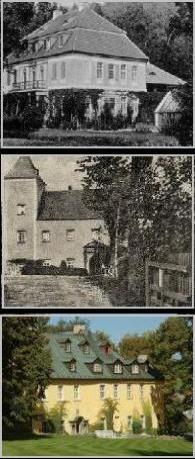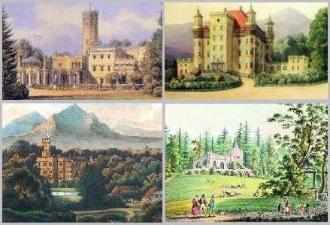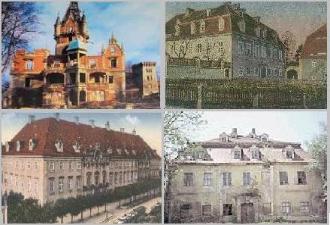| Erdmannsdorf palace was mentioned for the first time in 1305. Friedrich Wilhelm III of Prussia bought the palace and appointed Schinkel and Lenné to remodel palace and the park, which became one of the most beautiful landscape gardens in Silesia. After Friedrich Wilhelm's death, his successor, Friedrich Wilhelm IV of Prussia, reconvert the palace to plans by Friedrich August Stüler in neo- Gothic style. Until 1909, the stately home continued to be the summer residence of the Prussians kings and German emperors. |
| In 1822, the king's brother Wilhelm was actually the first Hohenzollern who took his summer residence in the Hirschberg valley at Fischbach. Schloss Fischbach is one of the best known palaces in the valley. It was first mentioned in 1364 as a moated castle and was expanded in the 15th century. Initially owned by the families Predel and Reichenbach, it was bought by Hans I. Schoff in 1476, who enlarged the castle with a two story mansion. After a fire in 1593, the building was again expanded with two new wings in Renaissance style. Beginning from 1844, it was reconstructed in neo-Gothic style according to plans by the prince himself. Wilhelm and his successors also equipped the palace with a remarkable art collection of medieval glass paintings and far eastern objects of art. |
| Schloss Schildau was one of three former royal Prussian summer residences in the valley. Since 1299, it was owned by family von Zedlitz. In 1839, Friedrich Wilhelm III of Prussia bought the building as a gift for his daughter Louise. In the following years the park was redesigned by Peter Joseph Lenné. |
| Buchwald was formerly owned by Countess von Reden, is now an academy with a park. "Buchwald is what in England is commonly called an ornamented farm, and the grounds are out altogether in the English taste. Nature is indeed here so extremely beautiful of herself that she will condescend to receive very little decoration from human ingenuity. Here are lawns and grottoes and cascades and running streams and parks which scarcely require anything more than enclosure to make English gardens." John Quincy Adams |
| Berthelsdorf, the home of the historic Count Nicolaus Ludwig Zinsendorf, and the near-by church became the spiritual center of the Moravian Pietists. It was also from Berthelsdorf that many instructions were issued to missionaries world-wide from members of the Moravian mission board. |
Schloss Plagwitz
Schloss Lähn am Bober
Burgruine und Schloss Lehnhaus
Schloss Waltersdorf am Bober
Schloss Langenau
Schloss Matzdorf
Schloss Paulinum in Hirschberg
Schloss Schwarzbach
Schloss Lomnitz
Schloss Arnsdorf
Schloss Lähn am Bober
Burgruine und Schloss Lehnhaus
Schloss Waltersdorf am Bober
Schloss Langenau
Schloss Matzdorf
Schloss Paulinum in Hirschberg
Schloss Schwarzbach
Schloss Lomnitz
Schloss Arnsdorf
Schloss Jannowitz
Schloss Kammerswaldau
Schloss Neuhof bei Schmiedeberg
Schloss Ruhberg in Schmiedeberg
Schloss Stonsdorf
Schloss Hermsdorf
Schloss Wernersdorf
Bad Warmbrunn Palais Schaffgotsch
Schloss Kammerswaldau
Schloss Neuhof bei Schmiedeberg
Schloss Ruhberg in Schmiedeberg
Schloss Stonsdorf
Schloss Hermsdorf
Schloss Wernersdorf
Bad Warmbrunn Palais Schaffgotsch
| Bad Warmbrunn was the palace of the Count of Schaffgotsch built ca. 1292, Schaffgotsch family seat after 1360 |

Lomnitz
Schloss Rohrlach (demolished)
Schloss Kupferberg (demolished)
Schloss Maiwaldau (demolished)
Schloss Boberstein (ruins)
Schloss Eichberg am Bober (ruins)
Schloss Kupferberg (demolished)
Schloss Maiwaldau (demolished)
Schloss Boberstein (ruins)
Schloss Eichberg am Bober (ruins)
| Other nearby castles and palaces included: |
| The stately homes turned the valley into an important garden landscapes in Middle Europe. At the end of the 18th century, artists and travellers discovered the valley. At Bad Warmbrunn there was the first touristic center. By the late eighteenth and early nineteenth century, better roads invited more tourists and several stately inns turned the area into an ideal and beautiful retreat. |
| Down in the Valley: Silesian Castles in Hirschberger Tal |
| German Silesia was full of enchanting castles, but one area had an especially rich abundance. The Hirschberger Tal (valley) in formerly German Silesia was cleared of forests by German colonists beginning in the late 13th century, and several villages and towns were established. During that time, the family of Schaffgotsch, who later owned the entire valley until their expulsion in 1945, also appeared for the first time in the region. In the middle of the 15th century, Silesian ruler Matthias Corvinus destroyed all Silesian castles, but from the Renaissance and Baroque era, the landscape of Hirschberger Tal in Silesia attracted the Prussian high nobility who built magnificent palaces, manors, parks and splendid estates. |

Matzdorf
Paulinum
Jannowitz
Ruhberg
Schwarzbach
Stonsdorf
Langenau
Kammerswaldau
Hermsdorf
Arnsdorf


| Erdmannsdorf, Fischbach, Schloss Schildau, Buchwald |
| Hirschberg Ruin, Berthelsdorf, Kynast, Berthelzin |